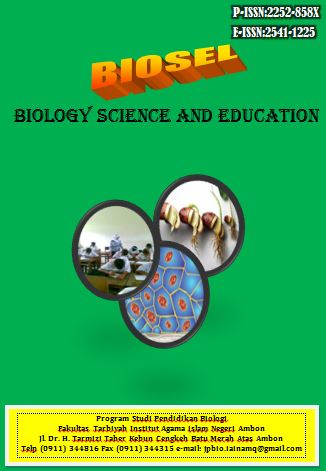Correlation between Plant Awareness Disparity and Plant Identification Ability in Preservice Teacher
DOI:
https://doi.org/10.33477/bs.v14i1.9263Abstract
Plant awareness disparity (PAD) is a phenomenon that indicates individuals' lack of attention or awareness towards plants in their surrounding environment. This gap can affect the ability of pre-service biology teachers to identify plant types. This study aims to analyze the correlation between PAD and plant identification skills in preservice teachers. This study aims to analyze the correlation between PAD and plant identification skills in students. The method used is correlational with instruments in the form of PAD questionnaires and local plant identification tests. The research population was all prospective biology teachers at Siliwangi University, totaling 518 people. Samples were taken using purposive sampling techniques, including 200 preservice biology teachers in grades 1 and 2. Data analysis using a simple regression correlation test, and based on the results of the analysis, it was found that PAD has a significant influence on plant identification ability, with a coefficient of determination (R²) value of 0.75. This shows that 75% of the variation in plant identification ability can be explained by PAD, while 25% is influenced by other factors outside the measured variables. This finding indicates that increasing awareness of plant diversity can improve the skills of prospective biology teachers in identifying plants. The implications of this study indicate the importance of learning strategies to increase awareness of the existence of plants in biology education and improve the plant identification skills of prospective teachers and enrich the botanical literacy of the next generation.
Keywords: Plant Awareness Disparity, Plant Identification, Preservice Teacher
Downloads
Published
Issue
Section
License

This work is licensed under a Creative Commons Attribution-NonCommercial 4.0 International License.
Authors who publish with this journal agree to the following terms: Authors retain copyright and grant the journal right of first publication with the work simultaneously licensed under a Creative Commons Attribution License that allows others to share the work with an acknowledgement of the work's authorship and initial publication in this journal. Authors are able to enter into separate, additional contractual arrangements for the non-exclusive distribution of the journal's published version of the work (e.g., post it to an institutional repository or publish it in a book), with an acknowledgement of its initial publication in this journal. Authors are permitted and encouraged to post their work online (e.g., in institutional repositories or on their website) prior to and during the submission process, as it can lead to productive exchanges, as well as earlier and greater citation of published work.













